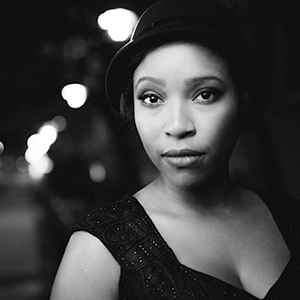The Harlem Renaissance

Actress Toya Turner who portrays Angel in Blues for An Alabama Sky (Joe Mazza).
Looking back on the Harlem Renaissance in 1940, the poet Langston Hughes, who never becomes more than a tantalizing offstage presence in Pearl Cleage’s Blues for an Alabama Sky, recalls the period as having been little more than a vain dream. Sure, it had been “a swell time while it lasted,” according to Hughes. But for those “Harlemites [who] thought the millennium had come” accompanied by “green pastures of tolerance created by” black poets, novelists, singers, bandleaders, and intellectuals, he had nothing but pity. “I don’t know what made any Negroes think that,” he writes, “except that they were mostly intellectuals doing the thinking. The ordinary Negroes hadn’t heard of the Negro Renaissance. And if they had, it hadn’t raised their wages any.”1
The cultural movement of the 1920s known as the Harlem, Negro, or Black Renaissance was fueled by what is now known as the First Great Migration, when hundreds of thousands of black Americans from the southern states fled disfranchisement and the expansion of Jim Crow segregation in the South to seek the greater social freedom and the labor opportunities created in Northern cities by the World War I and new restrictions on European immigration. The migration was in many respects a rank-and-file movement of men and women seeking better lives. But Hughes was certainly right about the role of intellectual figures in shaping the cultural moment. The historian David Levering Lewis has argued that the Harlem Renaissance was largely the collective brainchild of such figures as W.E.B. Du Bois, Charles S. Johnson, Alain Locke, A. Phillip Randolph, and Jessie Fauset who believed that the careful cultivation of literature and the arts could play a significant role in managing relations between blacks and other racial groups in urban centers. Black creativity and genius would elicit respect for the race generally, reducing prejudice and tension between blacks and whites. For various reasons, this belief was indeed a pipedream, and when the 1929 Stock Market crash precipitated the Great Depression, the idea that artistic innovation would bring with it economic prosperity and civic equality was largely tattered. By 1940 Hughes’s sober estimate of the period seemed warranted.
Nonetheless, the cultural landscape of the nation had been forever altered. What underwrote the idea of the Harlem Renaissance was the pluralist belief that every racial group was responsible for working out its own distinctive form and style of cultural expression. The path to becoming truly American ran not through embracing a generic Americanness but through some form of racial, ethnic or perhaps even regional particularity. The 1920s not only gave us the major writers and artists of the Harlem Renaissance (which, along with Hughes, include such figures as Zora Neale Hurston, Countee Cullen, Jessie Fauset, Nella Larsen, and Jean Toomer), but also the major writers of American modernism—Ernest Hemingway, F. Scott Fitzgerald, Willa Cather, William Carlos Williams, and William Faulkner—who are all preoccupied in one way or another with figuring out who “we” are and how “we” should go about expressing ourselves. Our America, as the literary historian Walter Benn Michaels has argued, is one where we have been enjoined to embrace and celebrate cultural difference. In the words of Cleage’s Guy Jacobs, who dreams of designing costumes for dancer Josephine Baker, “Harlem was supposed to be a place where Negroes could come together and really walk about”—a place of mutual black expression that would be appropriately echoed in other ethnic enclaves across the nation.
Undercutting the vision of collective black political power, as represented by another offstage presence in Blues—the Reverend Adam Clayton Powell, Jr., who succeeded his father as pastor of the prominent Abyssinian Baptist Church and would go on in 1945 to become the first African American New Yorker to be elected to the House of Representatives—was the fact that black Americans were never an homogeneous group. Delia’s belief that birth control and the right to abortion were key to the liberation of black women was indeed endorsed by the Abyssinian Baptist Church and influential individuals like Du Bois, and echoed in some Harlem Renaissance fiction, like Angelina Weld Grimke’s short story “The Closing Door” and Nella Larsen’s novel Quicksand, in which the refusal to bring black male children into the world was offered up as a protest against lynching. Even so, the opening of the first birth control clinic in Harlem by Margaret Sanger’s American Birth Control League was hardly an occasion of universal approbation, with some blacks fearing the League’s aims were too closely aligned with the eugenicists.
But for writers, performers, artists, particularly those whose sexualities did not adhere to prescribed social norms, 1920s Harlem was, if only for “a hot minute” a place where it seemed possible to construct what Langston Hughes called, “temples for tomorrow.” And if the moment of the Harlem Renaissance left us with some ideas we might be better off without, it also produced some of the most intriguing art and literature of the 20th century.
KENNETH WARREN is the Fairfax M. Cone Distinguished Service Professor at the University of Chicago. He specializes in African-American literature and 19th- and 20th-century American literature and critical theory. Warren is the author of So Black and Blue:Ralph Ellison and the Occasion of Criticism, Black and White Strangers: Race and American Literary Realism, and What Was African American Literature? (The W. E. B. Du Bois Lectures). He has been at University of Chicago since 1991.
1 Langston Hughes, The Big Sea (New York: Hill and Wang, 1940), p. 228.